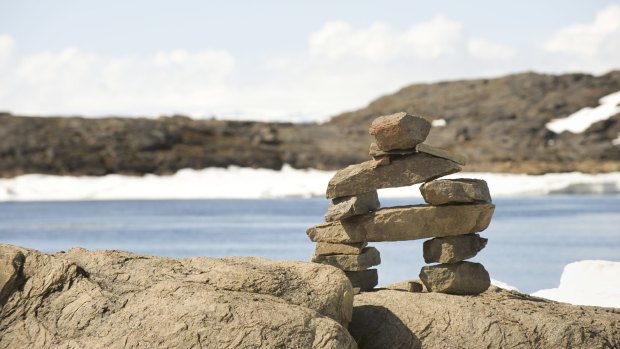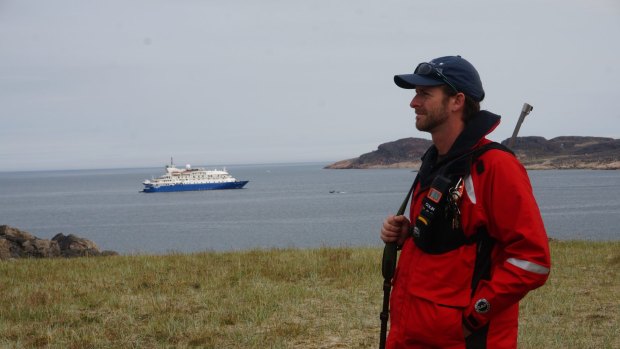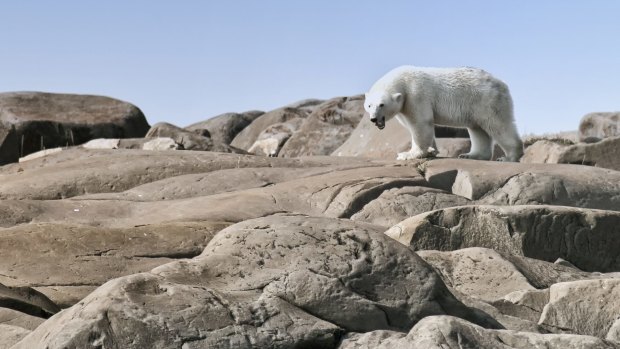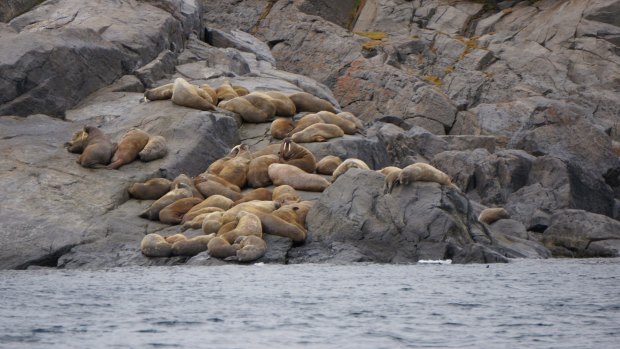This was published 9 years ago
Arctic cruise, Canada: Crew performs Arctic rite of passage
A motley crew prepares to perform one of Arctic tourism’s rites of passage - the polar plunge.
By Steve Meacham

Painting break: Inuit grandmother with two children take a break from painting their dog sled.
There's no going back now. For the past couple of days, we've been anticipating this moment with a mixture of fear and bravado. Yesterday the stunt had to be cancelled because the swell in that great Arctic ocean that is Canada's Hudson Bay was just far too treacherous.
But now it's a beautiful sunny summer's afternoon and the sea is mirror calm. So our motley crew of 15 are dressed, somewhat surreally, in luxury bathrobes ready to leap from the back deck of our specialist cruise ship to perform one of Arctic tourism's rites of passage - the polar plunge.
We haven't seen any icebergs for several days so we know the water can't really be described as freezing. Apparently it's a balmy 5 degrees centigrade but that's cold enough to earn bragging rights. And though we are no longer in the Arctic Circle, we're well within the botanical definition of Canadian Low Arctic.

Baffin Island: An inuksuk, a stone landmark or cairn built and used by the Inuit.Credit: iStock
Most of the other 75 passengers on the Sea Explorer have gleefully gathered on the upper decks to watch the polar plungers earn their certificates and post-plunge tot of vodka. The oldest among us is an American woman in her 60s, the youngest a 10-year-old Chinese boy.
We line up one by one, stripping off to swimming togs and flinching as the crew attach the cold, wet safety harness around us. Some jump and are barely submerged before they grab for the return ladder, others squeal and thrash about. I dive, and find to my amazement that it's not as instantly excruciating as expected. In fact it feels invigorating. But after five or six seconds, I can feel my body shivering uncontrollably. The tugging on the safety line tells me it's time to return to the ship.
This is the final day aboard the Sea Explorer, a luxury, ice-strengthened cruise ship chartered by polar specialists Quark Expeditions (and booked in Australia via Peregrine Adventures). Most of our voyage has been spent following in the wake of Henry Hudson, the 17th century British navigator and sea explorer who gave his name not only to Hudson Bay and Hudson Strait in what is now the Canadian Arctic, but also to New York's mighty Hudson River which he navigated in 1609 - having charted what is now Manhattan Island.
When spring came in 1611 and Hudson was still determined to keep searching for the North West Passage, a majority of the crew mutinied.
Hudson's obsession with discovering the North West Passage, an ice-free route which would cut weeks off the trade routes between northern Europe and the riches of the Orient, is one of the great tragic sagas of Arctic exploration. We are reminded of him during this voyage virtually every day - if only because his name also appears in the Hudson Bay Company, one of the oldest commercial corporations in the world.
His fate is foremost in our minds the day we board a fleet of Zodiac inflatables and go for a trek on Digges Islands at the north east entrance to Hudson Bay.
The night before, we had listened enthralled to a lecture on Hudson from the expedition team's historian, Laurie Dexter. He'd explained that on Hudson's fourth and final voyage of discovery, his ship Discovery had called in to Digges Islands to hunt for game, seals and fish.

On guard: The expedition team has already established there are no polar bears, posting a number of sentries with rifles on the surrounding hills in case any appear unexpectedly.Credit: Steve Meacham
Here, Hudson became only the second European explorer to encounter what were once called eskimos. They were actually Thule people, ancestors of today's Canadian Inuits.
By this time, Hudson was already at odds with his crew. Many wanted to spend the forthcoming winter at Digges Island, or somewhere equally plentiful. Hudson had only narrowly escaped a mutiny on his third voyage by returning to warmer waters but this time he was determined to press on.
You can understand why. Hudson Bay is twice the size of the Baltic Sea, and the navigator was convinced it was a huge ocean that would open to the Pacific. His logbook has never been discovered so we only have the account of survivors. But he pushed south as the weather got worse, venturing into James Bay only to find it was a dead end and that his ship was ice bound, his crew at the point of starvation.

On parade: Polar Bear, Canada.Credit: iStock
When spring came in 1611 and Hudson was still determined to keep searching for the North West Passage, a majority of the crew mutinied. A famous painting by John Collier shows Hudson being cast adrift in an open boat with his teenage son John and seven crewmen. The castaways were never seen again.
As for the mutineers, they returned to Digges Islands where they got into a skirmish with the Thules. Five of the crew were killed, including one of the ringleaders of the mutiny. The Discovery successfully returned to London where the mutineers eventually escaped the hangman. Laurie suggests that is because the British needed men with Arctic experience for future searches for the North West Passage.
As we step ashore onto Digges Islands, we're pretty sure we are not going to be attacked. The islands are now uninhabited and the expedition team has already established there are no polar bears, posting a number of sentries with rifles on the surrounding hills in case any appear unexpectedly (in which case, we'd beat an orderly retreat without hurting the bear).

Sun seekers: Walruses basking in the sun on Walrus Island, Hudson Bay.Credit: Steve Meacham
A lightning storm has struck, and it's hard to imagine anyone ever living here, especially in an Arctic winter. Yet for over 1000 years, even before the Thule arrived, people eked out a life on these two large rock outcrops separated by a central channel. They're known as the Dorset people because evidence of their existence was first discovered at Cape Dorset on the other side of the Hudson Strait.
Laurie has already delivered an onboard lecture explaining the difference between the Dorset and Thule peoples. Digges Islands, he tells us, is one of the best preserved Dorset archaeological sites in the Arctic.
Essentially, the Dorsets had very little going for them apart from an ability to endure. They hunted from the ice, basically seal because they lacked the technology to hunt whales. In summer they lived in tents, gathering together in winter to huddle in crude rock shelters.
When eventually the climate grew warmer and other wildlife came to the area, the Dorsets were quickly overrun by the more sophisticated Thules who swept in from Alaska around 800 years ago. Unlike the Dorsets, the Thules knew how to make kayaks and better harpoons to hunt whales and walrus, and they had brought dogs to pull their sleds allowing them to travel further afield for caribou, polar bear and musk ox. Within a generation or two, the Dorsets had disappeared.
Yet today we stroll over a low hill, admiring the springy carpet of tiny Arctic flowers and mosses that grow on the tundra, and find the remnants of an ancient village that once would have housed up to a 100 Dorset people. Without Laurie's expertise, we'd just see a pile of rocks. But he points out the individual homes, the central meeting house, and a cunning fox trap that could have been used for 1000 years.
A few days earlier, the Sea Explorer had taken us to Kimmirut, a tiny fishing community of 500 people on the southern coast of Baffin Island. Like many of the places we visit, this was once an important trading post for the Hudson Bay Company.
We've already watched an illustrated slide show delivered by Gwen Angulalik, a Canadian Inuit in her 60s who is travelling with us on the voyage. To our surprise, she announces that she was born in an igloo, one of 13 children of a fur trader. Her photos show a traditional life that has only recently disappeared, when fur skins were traded for foodstuffs, when seal fat was collected for oil lamps, when houses were insulated in winter with handmade snow blocks.
At Kimmirut, the locals also give us a taste of how the traditions have survived, despite the two supermarkets selling a depressingly expensive range of processed and packaged foods. After breaking up in small groups to be given a tour of the compact community, we assemble in the village hall where the men put on a display of traditional Inuit games, including a kind of eskimo sumo, a leg wrestling contest, and other man-to-man contests involving balance, strength and agility.
It's all very entertaining, but it's the women whose performance is most memorable as they demonstrate a form of throat singing, katajjaq, which is unique to the Inuit. Two women stand almost nose to nose, each projecting strange rhythmic tunes made as they breathe in and out of their throats. The first to run out of breath or break into laughter loses the contest.
We then gather in front of the small museum to watch an old man demonstrate how to butcher a ringed seal. He apologises through an interpreter for upsetting anyone's sensibilities, but says we should be aware this is the way of life he has known all his days.
As he expertly fillets the seal, setting aside delicacies like the liver, children crowd around him takingslivers of the bloodied, raw meat. Arctic char, polar cod, halibut, walrus and minke whales also feature in the local diet, and each community is allowed to kill up to 20 polar whales annually with the meat being divided communally.
There's a different, more worldly atmosphere the following day when the Sea Explorer calls in to Cape Dorset, the Papunya of the Canadian north. Like the famous birthplace of Australian desert dot painting, the town's reputation as the capital of Inuit art began with an outsider. In 1948, Canadian artist James Houston spent time studying Inuit culture on the southern side of the Hudson Strait.
Traditionally, Laurie tells us, the Inuit did not have art as such. They carved tools and weapons out of walrus tusks, whale bones and stone, but they didn't make objects for decoration or sheer enjoyment. Houston realised there was a flame waiting to be lit. Eventually he chose Cape Dorset as the place to set up an Inuit arts co-operative. Today it's a thriving community of about 1200 people, many of whom supplement their income by carving or making fine art prints. Some have international reputations with pieces selling for many thousands of dollars.
We're taken on our tour of half a dozen galleries, the best of which is the original co-operative founded in 1959, specialising in limited edition prints.
There's more art on show at the Eskimo Museum at Churchill, the largest port of Hudson Bay. There we disembark the Sea Explorer, feeling that we've become thoroughly immersed in the landscape, wildlife, culture and history of Hudson Bay.
But we polar plungers have been just a bit more immersed than anyone else.
Steve Meacham travelled courtesy of Peregrine Adventures.
TRIP NOTES
MORE INFORMATION
GETTING THERE: Qantas and its oneworld partner Emirates fly to Copenhagen from Sydney and Melbourne via Dubai. Qantas and American Airlines fly from Copenhagen to Sydney and Melbourne via Los Angeles. See qantas.com.au.
CRUISING THERE: Peregrine Adventures operates numerous Arctic and Antarctic polar cruises each year through its partner, Quark Expeditions. In 2015, the 13-day Baffin Island Explorer via Fury and Hecla, includes the west coast of Baffin Island and Hudson Bay, ending in Churchill. It costs from $11,730 a person, twin share.
Sign up for the Traveller Deals newsletter
Get exclusive travel deals delivered straight to your inbox. Sign up now.